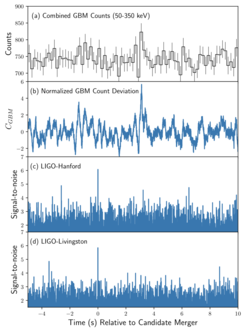Potential binary neutron star merger discovery in LIGO’s first observation run
Finding faint binary neutron star merger signals by cleverly combining gravitational-wave and gamma-ray observations
Researchers at the Max Planck Institute for Gravitational Physics (Albert Einstein Institute; AEI) in Hannover, Germany have developed and implemented a new search for binary neutron star collisions. It targets events which produce only faint gravitational-wave and gamma-ray signals and might therefore be missed by looking at only one kind of signal. The new method can increase the chances of finding these events by up to 70 %. The scientists tested their method on archival open data from LIGO’s first observing run (O1) and archival data from NASA’s Fermi Gamma-ray Space Telescope. They identified a potential binary neutron star merger candidate with a 1 in 4 chance of being astrophysical in origin.
One of the most studied astronomical transients of all time

GW170817, the first observation of the gravitational-wave signal from a binary neutron star merger, turned what would otherwise have been a relatively unremarkable gamma-ray burst detection, into one of the most studied astronomical transients of all time. It led to a better understanding of neutron star collision astrophysics, of the rate of these events in the Universe, and of the origin of heavy elements.
“The discovery of GW170817 demonstrated the possibility of finding gravitational-waves in coincidence with weak gamma-ray bursts. We target binary neutron star mergers which don’t produce a strong gravitational-wave or gamma-ray burst on their own,” explains Dr. Alex Nitz, a researcher in the Observational Relativity and Cosmology division of the AEI, and lead author of the publication to be submitted to a peer-reviewed journal. “With our method we find one potential candidate during O1, the first observing run of Advanced LIGO. The candidate has a 1 in 4 chance of being real. If that's the case it would be the furthest binary neutron star merger observed through gravitational and electromagnetic waves.”
Digging deeper by combining gravitational-wave and gamma-ray signals
The AEI researchers have previously produced the first open gravitational-wave catalog of binary mergers, from which they now selected weak candidates which looked like neutron star merger signals. They also identified possible faint gamma-ray bursts in data from the Gamma-ray Burst Monitor onboard the Fermi Gamma-ray Space Telescope.
By combining these two sets of observations and requiring that a gravitational-wave signal would be followed by a gamma-ray burst within 3.4 seconds, the scientists identified one potential candidate. Taking into account the estimated rate of these events and the observation time in O1, when both LIGO instruments were taking data, they found a 1 in 4 chance for the candidate to be real.
Possibly the most distant neutron star merger seen in gravitational waves
If confirmed, the signal would be the most distant binary neutron star merger observed in both gravitational and electromagnetic waves. The researchers find a distance somewhere between 330 million light-years and 1 billion light-years. GW170817 was about 130 million light-years from Earth.
The study “Potential Gravitational-wave and Gamma-ray Multi-messenger Candidate from Oct. 30, 2015” appears on the arXiv preprint server today and will be submitted to a peer-reviewed journal. Supplementary data are available at https://github.com/gwastro/o1-gwgrb.












